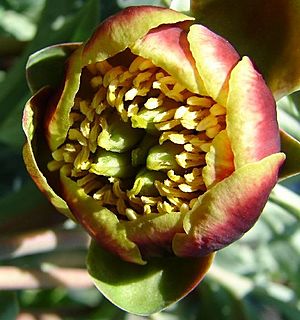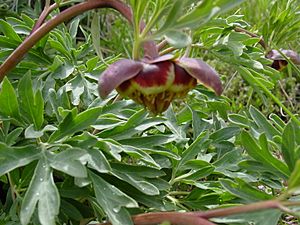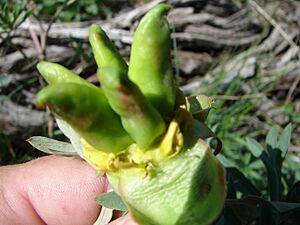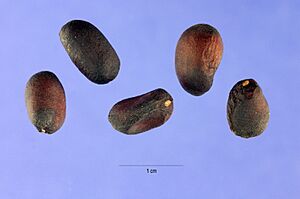Paeonia brownii facts for kids
Quick facts for kids Paeonia brownii |
|
|---|---|
 |
|
 |
|
| Scientific classification | |
| Genus: |
Paeonia
|
| Species: |
brownii
|
Paeonia brownii, also known as Brown's peony, native peony, or western peony, is a beautiful flowering plant. It's a type of perennial plant, meaning it lives for more than two years. This peony is usually short to medium in height. It has unique bluish-green leaves and small, nodding, maroon-colored flowers.
You can find Brown's peony growing naturally in the western United States. It often grows in higher places, sometimes under the shade of other plants. Its thick roots store food, helping the plant survive dry summers and grow new leaves and flowers each spring.
Contents
What Does Brown's Peony Look Like?
Paeonia brownii is a herbaceous plant, which means it has soft stems, not woody ones like trees. It grows about 25–40 centimeters (10–16 inches) tall. Each plant can have up to ten stems that grow from a large, fleshy root.
Its leaves are a cool bluish-green color and feel a bit fleshy. They might even get purple edges when it's cold! The leaves are shaped like ovals or upside-down eggs, about 3-6 cm long and 2-5 cm wide.
The flowers are cup-shaped and hang downwards. They are about 2–3 cm wide when fully open. These flowers bloom from March to June, usually in mid-April to mid-May, and stay open for about 9–15 days.
The flowers have five or six purplish-green sepals (leaf-like parts that protect the bud). Inside, there are five to ten petals. These petals are usually shorter than the sepals and change color from brownish-maroon at the bottom to wine red, then greenish or yellowish at the edges.
Each flower has 60-100 yellow stamens, which are the parts that produce pollen. The flowers also have two to six (usually five) smooth, yellow-green parts called carpels, which will later turn into fruits.
How is it Different from California Peony?
Brown's peony is very similar to the California peony. They both have small, drooping flowers and a noticeable center part called a disk. However, there are some key differences:
- Height: Brown's peony is usually shorter, about 20–40 cm tall. California peony is taller, 35–75 cm high.
- Leaves: Brown's peony has bluish-green leaves that narrow suddenly at their base. California peony has green leaves that gradually narrow or have no stalk at all.
- Petals: In Brown's peony, the petals are round and shorter than the sepals. In California peony, the petals are egg-shaped and longer than the sepals.
How Scientists Classify Brown's Peony
Scientists use a system called Taxonomy to name and group living things. Paeonia brownii was first described in 1829 by a botanist named David Douglas.
Brown's peony and California peony are grouped together in a special section of the Paeonia genus called Onaepia. Even though they are similar, scientists agree they are separate species because they have different looks, grow in different places, and don't overlap in where they live.
| genus Paeonia |
|
|||||||||||||||||||||||||||||||||
Where Did the Name Come From?
The species name brownii honors a Scottish botanist named Robert Brown.
Where Does Brown's Peony Grow?
Brown's peony likes to grow in open, dry pine forests, like those with Ponderosa Pine trees. It can also be found in areas with sagebrush or aspen trees. It grows at elevations from 200 to 3000 meters (about 650 to 9,800 feet) high. These areas have long, cold winters with little snow and short growing seasons.
You can find this plant in several western US states, including northern California, Idaho, Montana, Nevada, Oregon, Utah, Washington, and Wyoming. It does not grow naturally in Canada.
Brown's peony is very picky about its soil. It needs soil that drains well, meaning it can't be too wet or too dry.
How Brown's Peony Lives
In places like the Blue Mountains, Brown's peony grows in grassy areas near conifer trees. It shares its home with many other plants, like different types of grasses, monkshood, balsamroot, and various wildflowers.
Brown's peony avoids dry periods by completely dying back in early summer after it flowers. It then survives underground using the food and energy stored in its thick roots.
If parts of the plant are broken or damaged, it gives off a strong, bitter, and unpleasant smell. This smell helps protect it from being eaten by animals. Caterpillars of certain moths have been seen eating small holes in the flowers, but these insects usually prefer other plants. The flowers themselves also have a faint version of this smell and produce a sweet, but slightly bitter, nectar.
Pollination
Pollination is how plants reproduce, often with the help of insects. For Brown's peony, wasps and certain types of bees are the main pollinators. These insects visit the flowers to collect nectar.
Even though the plant produces a lot of pollen, the insects mostly come for the nectar. The plant's nectar is a type called "hexose," which means it's high in glucose sugar. The plant's unique, slightly unpleasant smell also helps attract the right kind of pollinators.
Seed Dispersal
The seeds of Paeonia brownii are partly spread by small rodents like chipmunks and mice. These animals collect the seeds from the ripe fruits and store them in small hidden spots, sometimes up to 20 meters away.
However, peony seeds are not as popular as pine nuts, which have more fat and protein. Any forgotten seeds will sprout and grow into new plants the following year.
Growing Brown's Peony in a Garden
Brown's peony is not commonly grown in gardens. This is because it doesn't have many large, showy flowers, and it's quite difficult to keep alive. It really dislikes too much water during its summer resting period. If you try to grow it, you need to plant it in a spot with excellent drainage, where it won't get too much rain in the summer. It can grow well in sandy soil.
Uses of Brown's Peony
Native American tribes traditionally used the roots of Brown's peony. They would make a tea from the roots to help treat lung illnesses.
The roots of Paeonia brownii are edible and were used for many health benefits. Native North American Indian tribes used the plant's roots as medicine for various conditions, including coughs, kidney problems, pneumonia, nausea, indigestion, and tuberculosis.



